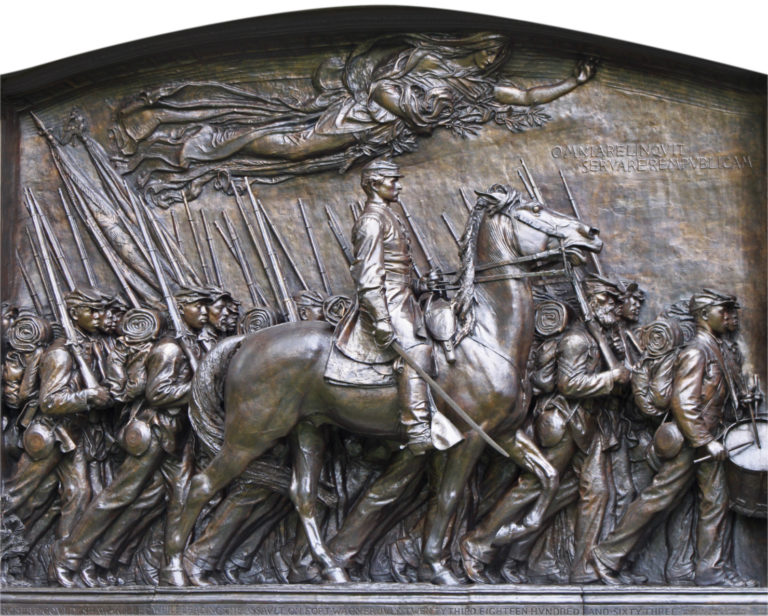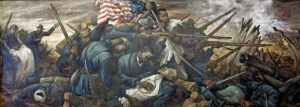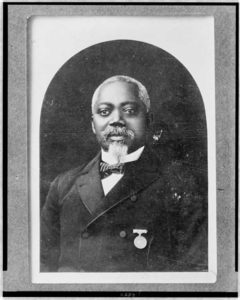The 54th Massachusetts Infantry Regiment and Boston Harbor

Robert Gould Shaw 54th Regiment Memorial. Photo credit: NPS.
“Once let the black man get upon his person the brass letter, U.S.; let him get an eagle on his button, and a musket on his shoulder, and bullets in his pocket, and there is no power on the earth or under the earth which can deny that he has earned the right of citizenship in the United States.” – Frederick Douglass, “Address for the Promotion of Colored Enlistments, delivered at a mass meeting in Philadelphia, July 6, 1863.”
During the Civil War, Gallops Island played an important role as a discharging post for several Massachusetts units returning from combat. This included three of the nation’s first regiments composed of African American soldiers: the 5th Massachusetts Cavalry, the 55th Massachusetts Infantry, and the 54th Massachusetts Infantry.
 “The 54th Massachusetts regiment, under the leadership of Colonel Shaw in the attack on Fort Wagner, Morris Island, South Carolina, in 1863.” mural located at the Recorder of Deeds building, built in 1943. 515 D Street, NW, Washington, DC. Photo credit: Library of Congress.
“The 54th Massachusetts regiment, under the leadership of Colonel Shaw in the attack on Fort Wagner, Morris Island, South Carolina, in 1863.” mural located at the Recorder of Deeds building, built in 1943. 515 D Street, NW, Washington, DC. Photo credit: Library of Congress.
The 54th is most famous for leading the brave charge against the heavily defended Confederate position at Fort Wagner on July 18, 1863. Of the unit’s 600 men around 115 men were killed and about 156 men were captured or wounded. The unit’s commander, Colonel Robert Gould Shaw, was among those killed. The Union forces were not able to capture the fort, however, the valor of the 54th helped to increase enlistment among African Americans. The unit also fought for equal pay and boasted the first African American soldier to receive the Medal of Honor, Sergeant William H. Carney. By 1865, over 180,000 African Americans had served during the war.

Sgt. William Carney. Photo credit: Library of Congress
The 54th continued to serve in South Carolina and Florida. They mustered out of service on August 20, 1865 in Mount Pleasant, South Carolina. They travelled to Gallops Island in the Boston Harbor and remained there until September 2nd. While there they returned most of their equipment to the government but were given the option to purchase their weapons. Many men did buy their arms to save as mementos of the war and for posterity for future generation.
Upon the unit’s return, the Boston Daily Evening Transcript wrote: “this command, – which now returns crowned with laurels and after 200,000 of their brethren, from one end of the traitorous South to the other, have fought themselves in public esteem,- had such a reception today as befitted an organization the history of which is admitted to form so conspicuous a part of the annals of the country.” The men received a hero’s welcome with crowds cheering as they marched up State Street to the Boston Common. They were then thanked for their service and dismissed at the Charles Street Mall. The men then began their journey home with many returning to places as far away as Washington, DC, and Ohio. Today, the 54th is immortalized in the Robert Gould Shaw and Massachusetts 54th Regiment Memorial. The memorial was unveiled in 1897 and stands across from the State House at the edge of the Boston Common.
Visit our partners at Boston African American National Historic Site and Fort Sumter and Fort Moultrie National Historical Park to learn more!
Bibliography
Boston Daily Evening Transcript, September 2, 1865.
Emilio, Luis Fenollosa Emilio. History of the Fifty-Fourth Regiment of Massachusetts Volunteer Infantry, 1863-1865. Boston: The Boston book co., 1891.